Image from QUANTIFICATION OF REPARATIONS FOR TRANSATLANTIC CHATTEL SLAVERY, prepared by Coleman Bazelon Alberto Vargas Rohan Janakiraman Mary M. Olson PREPARED FOR The University of the West Indies and The American Society of International Law’s, Second Symposium on Reparations Under International Law June8, 2023
The International Symposium on the Lawfulness of Transatlantic Chattel Slavery (TCS) , co-sponsored by the American Society of International Law (ASIL) and the University of the West Indies (UWI), was held on 20- 21 May 2021.
A Second Symposium on the reparations due for TCS was held on 9-10 February 2023. At that Symposium, the Brattle Group presented their Report on Reparations. An Advisory Committee was established to resolve difficult issues arising from the assessment of reparations. The Committee consists of Chantal Thomas, Professor of Law, Cornell University, Verene Shepherd, Professor of Social History and Director of the Centre for Reparations Research, Robert Beckford, Professor of Social Justice at University of Winchester, Professor of Theology at the Queen's Foundation in Birmingham and Professor of Theology at Vrije University in Amsterdam, and Patrick Robinson, Honorary President of ASIL.
The first symposium concluded that the legality of transatlantic chattel slavery depended on the law of the country in which the transaction of enslavement took place. Those transaction took place in African countries, the law and practice of which were opposed to TCS. A second conclusion was that TCS breached a normative principle of humanity which called for respect of the inherent dignity and personhood of all human beings, including Africans. Thus, it was concluded that TCS was unlawful on the basis of the law applicable at that time.
The question, remains:
How then, do we hold the guilty criminals responsible and secure reparatory justice now?
According to the Report on Reparations for Transatlantic Chattel Slavery in the Americas and the Caribbean published by the Battle Group, June 8, 2023,
“In order to assess the reparations that are due it must be established that the injuries or harm suffered by the enslaved are the consequence of wrongful conduct by those who carried out transatlantic chattel slavery. . . The legal basis for reparations is set out in a well-known case, the Factory at Chorzów, in which the Permanent Court of International Justice (PCIJ) stated
‘it is a principle of international law that the breach of an engagement involves an obligation to make reparation in an adequate form’;
reparation
‘must, as far as possible, wipe out all the consequences of the illegal act and re-establish the situation which would, in all probability, have existed if that act had not been committed.’
This principle is reflected in Article 31 of the International Law Commission’s Articles on Responsibility of States for Internationally Wrongful Acts (hereinafter, the ILC Articles on State Responsibility), which provides that
‘the responsible State is under an obligation to make full reparation for the damage caused by the internationally wrongful conduct’.
The forms of reparation are restitution, compensation and satisfaction; these are reflected in Articles 35, 36 and 37 respectively of the ILC Articles on State Responsibility. . . .
One of the most important legal requirements in reparations is to establish causation, that is, that the alleged injury or damage is the consequence of the wrongful conduct of the States that carried out TCS, or in the language of the ICJ, that
‘there was a sufficiently direct and certain causal nexus’ between particular acts carried out in the practice of TCS and the injury suffered.’”
Here, then, is the importance of the Mandate from the Afro Descendant People Issued to the Permanent Forum on People of African Descent to Request an Advisory Opinion from the International Court of Justice on their Status as Prisoners of War Under the Geneva Convention. The Requst for the Advisory Opinion of the ICJ seeks confirmation from the ICJ on the fundamental questions establishing direct and certain causal nexus’ between particular acts carried out in the practice of TCS and the injury suffered. Specifically, the Request for the Advisory Opinon of the ICJ seeks to establish the origina and foundation of TCS in the Dum Diversas Apostolic Edict declaring total war on the “land of Guine"‘ by Pope Nicholas V on June 18, 1452. The Dum Diversas declaration of war was followed up with monopoly contracts known as “Asientos” which were variously granted by the Catholic Church to private merchants from 1518 to 1595, to Portugal from 1595 to 1640, to the Genoese (Italy) from 1662 to 1671, to the Dutch and Portuguese from 1671 to 1701, to France 1701-1713, the British 1713 to 1750, and the Spanish 1765 to 1779. In the United States, several colonies became combatants to the Dum Diversas War when they legalized slavery: Massachusetts in 1641; Connecticut in 1650; Virginia in 1657 and Maryland in 1663. Other colonies followed and the United States of America officially entered the Dum Diversas War trafficking of people from Guine after American independence in 1776.
The Dum Diversas and Asiento contracts, then, establish the direct and certain causal nexus of the Transatlantic Chattel Slavery.
The next step in legal reparatory justice at this moment is for the ICJ to once and for all settle these questions:
(a) Is the Dum Diversas apostolic decree issued by Pope Nicholas V on June 18, 1452 a declaration of “total war” - warfare that includes any and all civilian-associated resources and infrastructure as legitimate military targets, mobilizes all of the resources of society to fight the war, and gives priority to warfare over non-combatant needs - and therefore a war crime and a crime against humanity? Is there a statute of limitation regarding reparations for this war crime and crime against humanity?
(b) Were the people captured as a result of the Dum Diversas apostolic decree “prisoners of war” and do their descendants retain that status until their final “release and repatriation” under the Geneva Convention?
On June 2, 2023, the President of the Permanent Forum on People of African Descent (PFPAD), Ms. Epsy Campbell-Barr had the opportunity to take the next step by signing the Request for the Advisory Opinion of the ICJ. Unfortunately she declined against the will of 248 signatories to the Mandate insisting that she exercise PFPAD’s mandate to do so and the popular support among the delegates at the second session of PFPAD held in New York. AN OPEN LETTER TO EPSY CAMPBELL BARR IMMEDIATELY FOLLOWING THE CLOSE OF THE 2ND SESSION OF THE PERMANENT FORUM ON PEOPLE OF AFRICAN DESCENT was sent requesting an explanation.
Meanwhile, the 2nd Session of the Forum’s Preliminary Conclusions and Recommendations. Point 16(b) calls for a specialized international tribunal constituted to adjudicate reparations claims following the proposal from Barbados and 16(c) calls for an international UN Task Force of Reparatory Justice, ostensibly following the proposal made by Justin Hansford in his opening address to convene
“a new community of legal thinkers that is not limited to lawyers, but includes anyone who is passionate about justice. And we come together and demand that many of the states in this room that have benefitted from the legacy of our oppression start the process of apology and reparation, but not on their terms, but on our terms.”
But this has already been done.
Ransom and Such (1990) calculated that the profits of the slave system from 1806 to 1860 compounded to 1983 came to $3.4 billion. The present value of that sum compounded to the present at an annual interest rate of 5 percent is $9.12 billion.
Larry Neal (1990) derived an estimate of $1.4 trillion based on the gap between the wage an enslaved African would have received had he or she been a free laborer and what was spent on slave maintenance by slave-owners between 1620 and 1840. Again, compounding the interest to the present at 5 percent interest yields a total close to $4 trillion by the end of 2004.
James Marketti (1990) utilized a concept of income diverted from enslaved Africans during the course of slavery in the United States to arrive at a figure of $2.1 trillion by 1983.The present value after compounding the interest is $6 trillion. If you use the "40 acres and a mule" from General Sherman's Special Orders No. 15 for a family of four, then, a conservative estimate of the price of land in 1865 is $10 per acre. A conservative estimate of the total number of ex-slaves at the time of emancipation is 4 million which would yield 40 million acres of land valued at $400 million should have been distributed to the ex-slaves in 1865. The present value of that sum of money compounded from 1865 at 6% would amount to $1.3 trillion. If there are approximately 30 million descendants of enslaved Africans in the United States today, the estimate based on 40 acres yields an allocation of slightly more than $400,000 per recipient.
Chachere and Udinskly (1990) estimate that the gains to whites from labor market discrimination during the period 1929-1969 to be $1.6 trillion.
By the year 2000, Joe R. Feagin in his paper Documenting the Costs of Slavery, Segregation and Contemporary Discrimination concluded that
‘Clearly, the sum total of the worth of all the black labor stolen by whites through the means of slavery, segregation, and contemporary discrimination...taking into account lost interest over time and putting it in today's dollars, is perhaps in the range of $5 to $24 trillion.’
In late 2000, a new project called the Reparations Assessment Group began making preparations for lawsuits. The dollar sums mentioned were staggering. Harper’s magazine estimated that it could require $97 trillion to pay for the hours of uncompensated work done during the slavery era, which would require extracting, on average, about $300,000 from every American of non-slave descent.”
On June 8, 2023, the Brattle Group presented its QUANTIFICATION OF REPARATIONS FOR TRANSATLANTIC CHATTEL SLAVERY concluding that,
“The harm caused by transatlantic chattel slavery was vast, and its repercussions resonate in the lives of descendants of the enslaved to this day. Each enslaved person experienced overwhelming harm, beginning with the loss of their liberty and often ending with a premature death after a life marked by personal injury and other forms of violence, if they survived the Middle Passage. By our estimates, these harms were inflicted on 19 million people over the span of four centuries. These 19 million include those Africans kidnapped and transported to the Americas and Caribbean and those born into slavery. Given the depth, breadth, and duration of the harm, quantifying the associated reparations is a daunting task. . . .To meet this challenge, we begin by separating the harm into two broad temporal categories. First for harm during the period when chattel slavery was carried out and, second, for continuing harm thereafter. . . .For the period of enslavement, including any post-emancipation period of ‘apprenticeship’ where the formerly enslaved were ‘earning’ their freedom, we estimate US$77 trillion to US$108 trillion in reparations.”
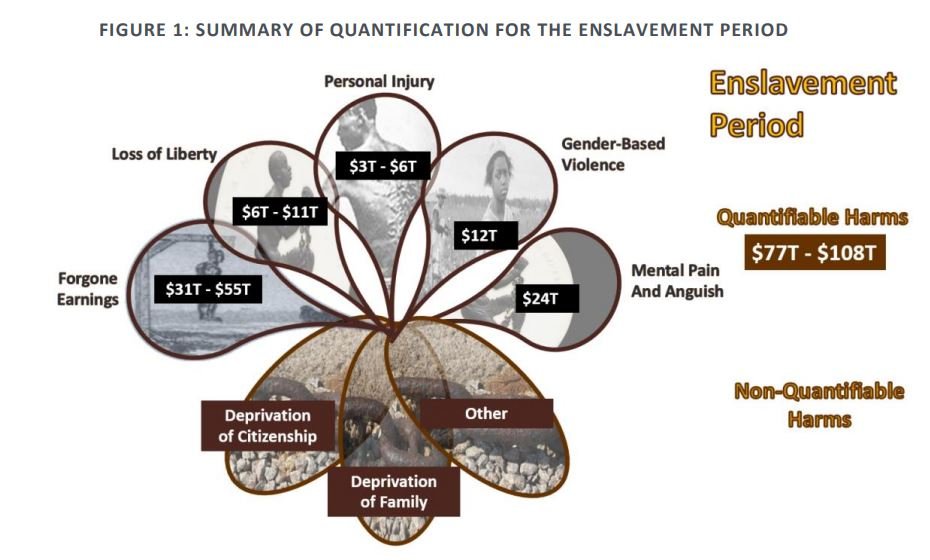
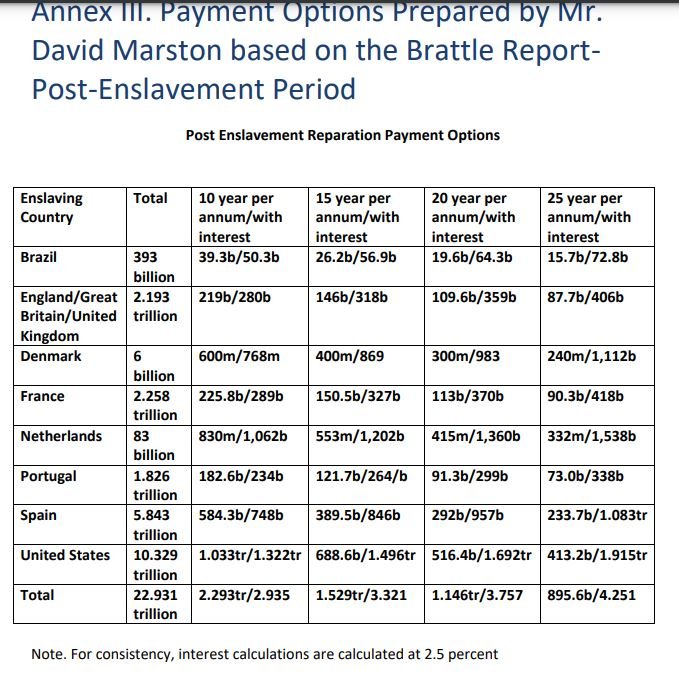
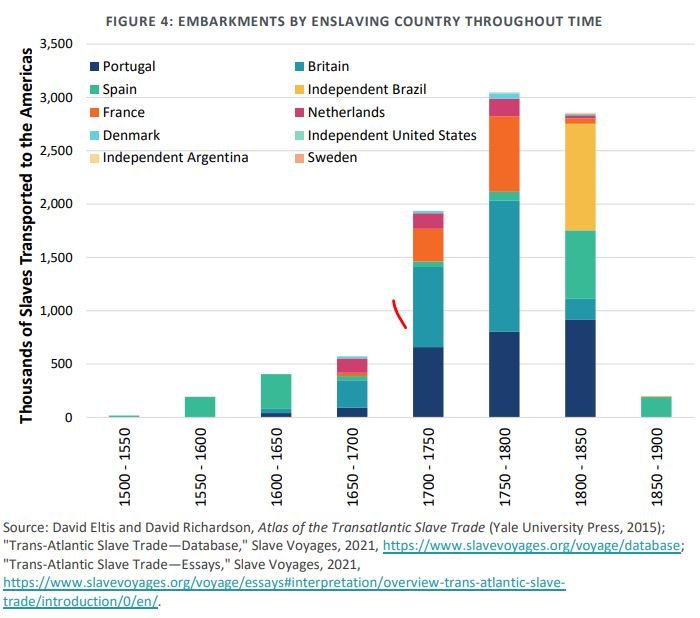


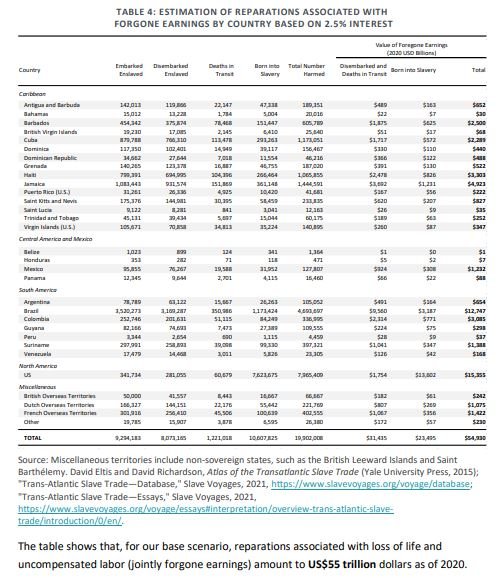


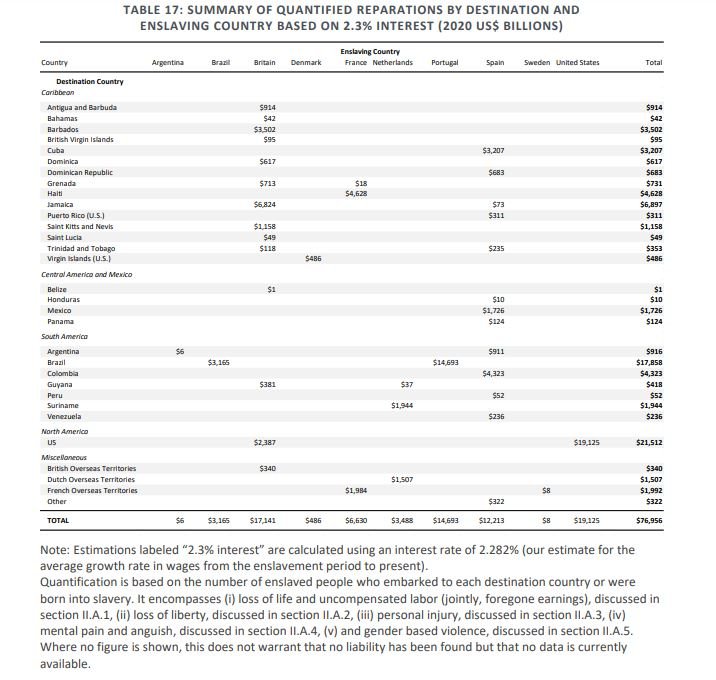

We don’t need to delay reparatory justice by convening yet another study group. What is needed now is to engage the ICJ in the only manner open to people of African Descenent in the African Diaspora - using Un resultion 75/314 that creates the PFPAD and gives it the authority to request advisory opinions from the ICJ.
What is needed now is for the ICJ to issue its advisory opinion on whether or not
The Dum Diversas and Asiento contracts, then, establish the direct and certain causal nexus of the Transatlantic Chattel Slavery.





















































































































